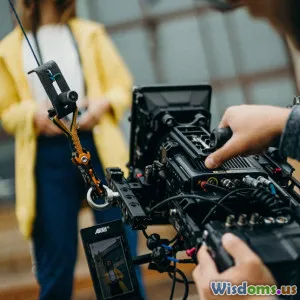
Breaking Boundaries in Filmmaking
7 min read Explore how innovative technology and creativity are revolutionizing filmmaking, breaking traditional boundaries with stunning examples. (0 Reviews)
Breaking Boundaries in Filmmaking: The Fusion of Art and Innovation
Filmmaking has always been a dynamic blend of art and technology, but recent decades have ushered in an extraordinary era where traditional limits are continually challenged and transcended. What was once constrained by physical film reels, bulky cameras, and limited special effects has now evolved into a playground of creative freedom fueled by digital innovation, immersive storytelling, and new cinematic philosophies.
This article dives deep into how filmmakers are breaking boundaries, changing the way stories are told, seen, and experienced.
The Dawn of Digital Technology: A Paradigm Shift
In the early 2000s, the transition from analog to digital cameras revolutionized filmmaking.
Example: Peter Jackson’s "The Lord of the Rings" trilogy (2001-2003), although shot primarily on film, combined traditional shooting with early digital effects that set new standards for fantasy visuals. By the time James Cameron directed "Avatar" (2009), digital cameras and 3D technology enabled an unprecedented immersive cinematic experience.
Digital technology has democratized filmmaking. Affordable digital cameras and editing software allow independent filmmakers worldwide to produce high-quality content without studio backing. According to a 2021 Statista report, the number of short films released online annually more than doubled in the digital era, illustrating a global surge in creative output.
Virtual and Augmented Reality: Immersive Storytelling Takes Center Stage
Virtual reality (VR) and augmented reality (AR) technologies are not just buzzwords; they represent a new frontier in narrative media. VR allows viewers to step inside the story, exploring spaces and perspectives that a traditional screen can’t offer.
Real-World Insight: Filmmaker Chris Milk calls VR “the ultimate empathy machine,” emphasizing how VR films like "Dear Angelica" immerse users in intimate stories where they are participants, not mere observers.
Augmented reality adds layers to live environments, often used in experimental films and interactive exhibitions. Museums and film festivals worldwide, such as Sundance’s New Frontier section, showcase cutting-edge AR storytelling.
AI and Machine Learning: Revolutionizing Pre-Production to Post-Production
Artificial intelligence is reshaping workflow in filmmaking from scriptwriting to editing.
For instance, AI-assisted script analysis can predict audience reactions and optimize narratives. AI-driven editing tools automatically sort through thousands of hours of footage to identify the best takes, easing the post-production bottleneck.
Case Study: The short film "Zone Out" leveraged AI algorithms to enhance color grading and sound design, slashing post-production time by 30%.
AI is also influencing visual effects, generating hyper-realistic CGI faces or entire digital actors, such as the resurrection of actors through deepfake technology—a double-edged sword presenting exciting opportunities and ethical dilemmas.
Breaking Traditional Storytelling Structures
Moving beyond technology, the narrative itself is evolving.
Films like "Memento" (2000) and "Pulp Fiction" (1994) disrupted conventional linear narratives, inspiring a generation to experiment with fragmented timelines.
Today, streaming platforms like Netflix promote interactive films such as "Black Mirror: Bandersnatch," where viewers choose story paths, blending gaming with cinema to create personalized experiences.
Additionally, global storytellers are integrating culturally diverse perspectives and non-Western cinematic traditions, enriching the global film landscape and challenging historically dominant narrative norms.
The Rise of Cinematic Giants from Unexpected Platforms
The boundary between traditional cinema and internet content is increasingly blurred.
YouTube creators and independent filmmakers have gained massive audiences; for example, Spike Jonze’s short film "Welcome Home" was produced by Apple Plastic and showcased the possibilities of branded content combined with cinematic quality.
Moreover, streaming services invest millions in original films and documentaries, shifting power away from Hollywood studios and broadening the definition of successful filmmaking.
Sustainability and Ethical Innovation in Filmmaking
As the industry pushes technological and creative boundaries, sustainability has become a critical consideration.
Productions are adopting greener practices, such as digital distribution reducing physical media waste and LED virtual sets lowering energy consumption compared to traditional location shoots.
Ethical storytelling is another frontier—filmmakers are increasingly responsible for authentic representation and avoiding exploitative narratives.
The #OscarsSoWhite movement highlighted systemic exclusion, prompting a re-evaluation of industry norms and an expansion of voices shaping cinema.
Conclusion: The Future—a Canvas Without Borders
Filmmaking’s future is bright and boundless, propelled by technological innovation, novel storytelling methods, and a more global and inclusive perspective. By embracing VR, AI, sustainability, and diverse narratives, filmmakers are not just breaking boundaries—they are redefining what cinema can be.
Aspiring filmmakers, industry professionals, and enthusiasts alike should stay open to these evolving trends and tools. This era's magic happens at the intersection of creativity and technology, where new cinematic realities await discovery.
Takeaway: Whether through immersive virtual worlds, AI-enhanced storytelling, or ethically grounded narratives, the power to create meaningful, groundbreaking cinema lies within reach. It's time to break your own boundaries.
References:
- Statista, "Number of films released by independent filmmakers" (2021)
- Sundance Film Festival Archives, New Frontier Section
- Chris Milk, "The Impact of Virtual Reality on Empathy," TED Talk 2016
- Case study: "Zone Out" AI post-production innovation
- Industry reports on sustainability in filmmaking
Engage with innovation, challenge norms, and create films that resonate across cultures and technologies—welcome to the new age of filmmaking.
Rate the Post
User Reviews
Popular Posts





















